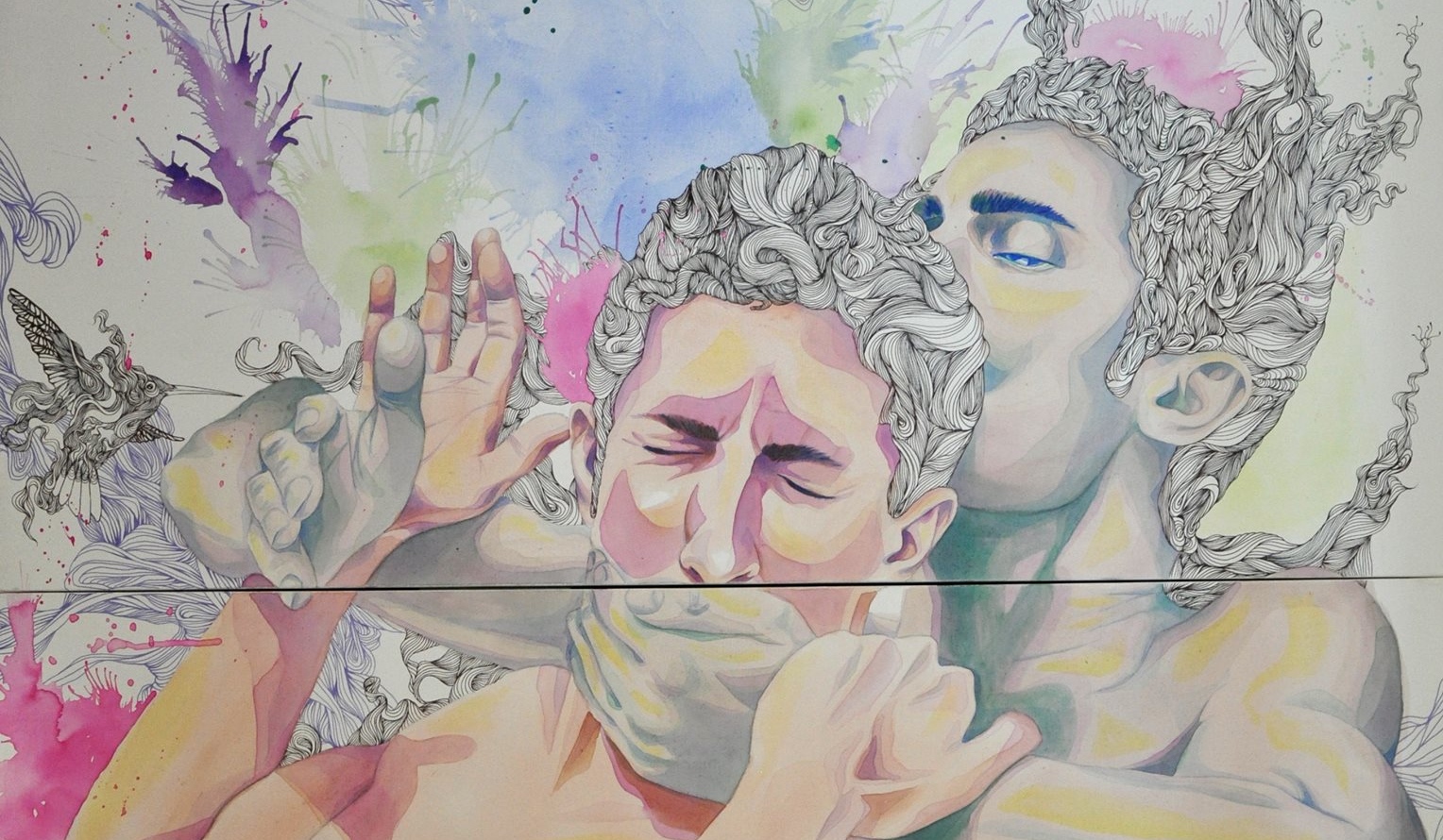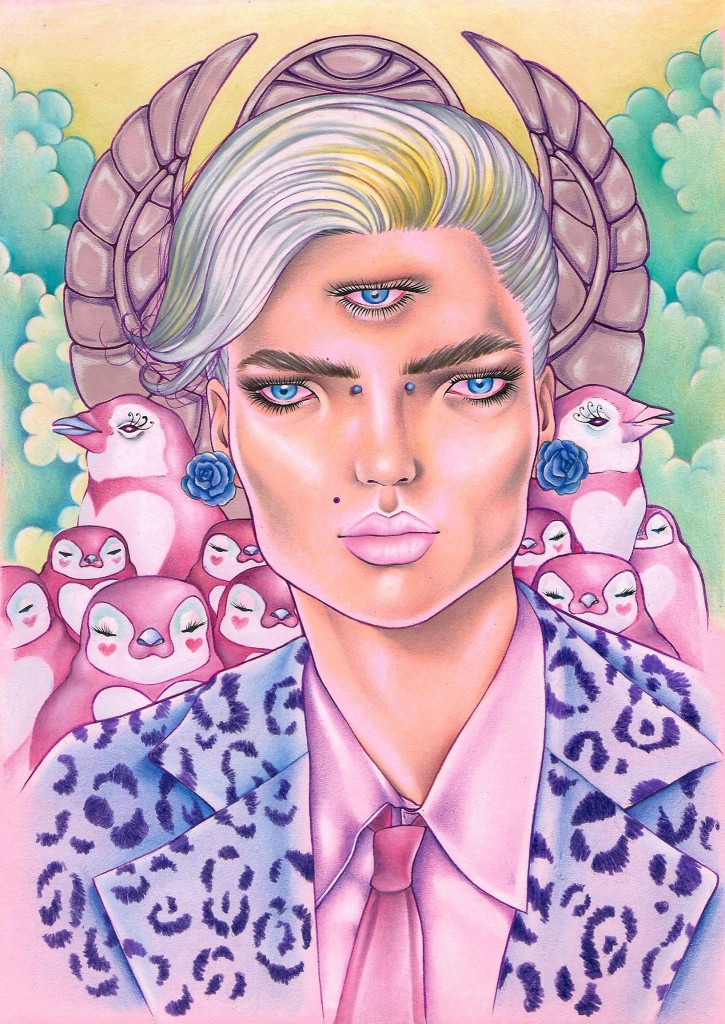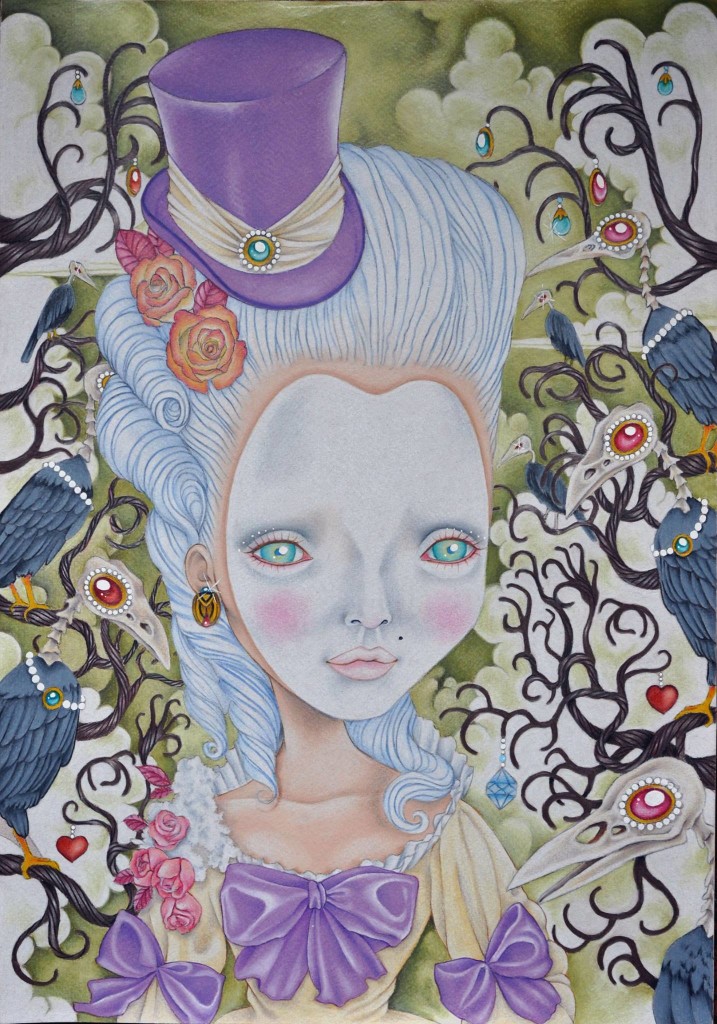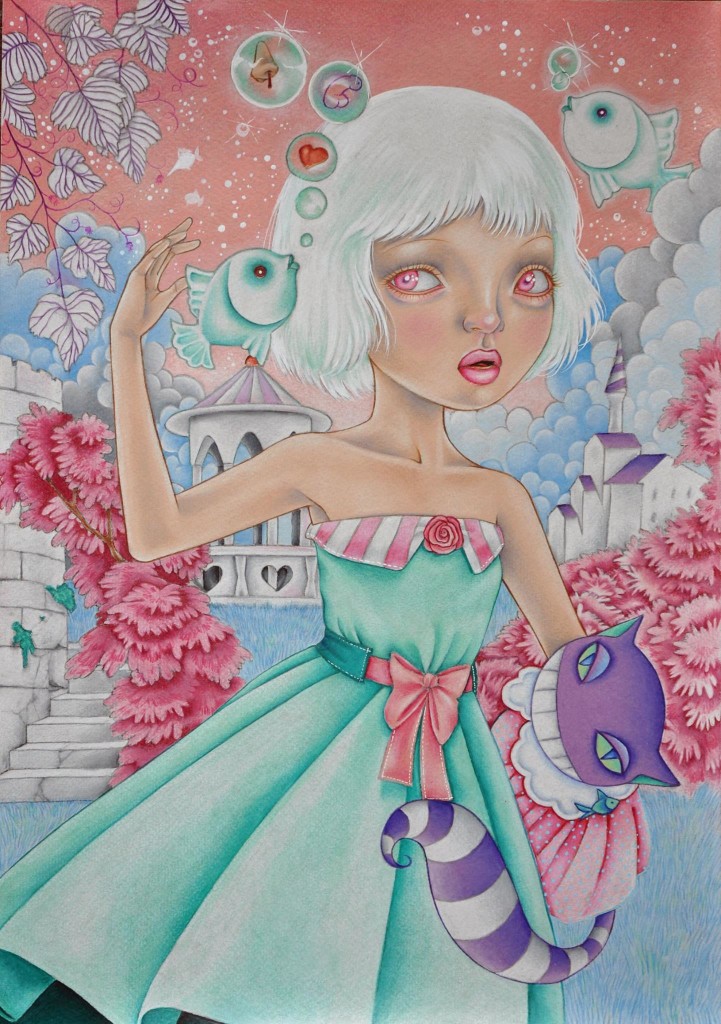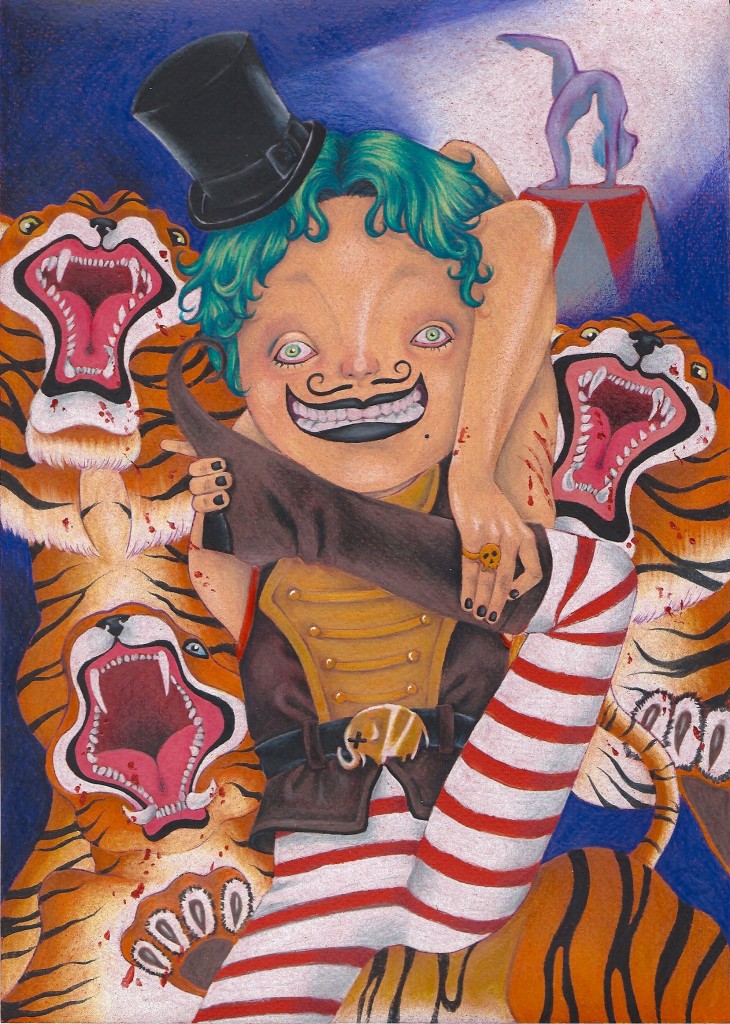Quello di Gianluca Cambriani è un universo surreale ed affascinante, dove lo spettatore non può che perdersi tra l’accuratezza dei mille dettagli, dove le forme si intersecano tra loro per raggiungere l’armonia e il colore con la sua carica rende vive tutte le composizioni. Un pittore che procede verso una continua ricerca estetica, che nel corso degli anni si rimodella attraverso differenti modalità espressive, tutto all’insegna della sperimentazione e della poliedricità, come testimonia anche l’uso che l’artista fa anche della macchina fotografica che da tempo accompagna la sua produzione. Le opere che realizza sono tra loro molto varie, tutte però possiedono una forte carica emotiva che suscita sentimenti contrastanti: sono composizioni sensuali ma raffinate, oniriche e seducenti, che risentono sia dell’influenza di movimenti artistici più recenti come il pop-surrealismo, ma anche dei grandi maestri del passato.
Noi di The WalkMan Magazine abbiamo cercato di svelarvi tale universo scambiando quattro chiacchiere con questo talentuoso artista.
Come ti sei avvicinato al mondo dell’arte e quando hai capito che questo avrebbe ricoperto un posto determinante nella tua vita?
Se devo dirti la verità mi sono sempre sentito parte di questo mondo, fin da quando ero bambino ho avuto la passione per il disegno, in più mia madre mi portava spesso a vedere musei e monumenti alimentando perciò il mio interesse. Questo è stato quindi un po’ un percorso naturale che mi ha portato poi a scegliere il liceo artistico ed a proseguire gli studi nell’Accademia di Belle Arti di Roma dove mi sono laureato.
La tua produzione spazia tra la pittura e la fotografia, qual è però l’ambito in cui ti senti più portato e che riveste per te una maggiore importanza?
Sono partito con la pittura, ma in realtà già prima praticavo il disegno, la decorazione e l’illustrazione, perciò questo ambito in qualche modo ha sempre ricoperto un ruolo determinante e ormai mi accompagna da tempo; la fotografia invece è stata una scoperta più tardiva ma per questo non meno appassionante, mi sono avvicinato all’obiettivo fotografico circa cinque anni fa e fin da subito ne sono rimasto molto coinvolto, mi piace infatti sperimentare e realizzare un genere di foto che non si vede normalmente.
I ritratti che realizzi sono sempre tra loro molto diversi, si va da una figurazione iperrealista ad una più caricaturale e surreale. Quali sono le ragioni di questa continua e cangiante sperimentazione?
Diciamo che tutto il percorso che mi ha portato fin qui è stato da sempre molto variato e sperimentale perché mi piace spaziare tra più stili e forme e non fossilizzarmi su un unico modulo espressivo. Ho iniziato a dipingere ispirandomi ad alcuni maestri della pittura quattro-cinquecentesca e dopo mi sono avvicinato anche al mondo dei fumetti e dei manga, successivamente sono riuscito a coniugare la pulizia dell’illustrazione di influenza giapponese ad una espressività e resa anatomica più occidentale. Il tutto si concentra prevalentemente su una ricerca estetica volta all’esaltazione della forma e del bello, proprio per questo cerco di prestare particolare attenzione alle anatomie dei personaggi che realizzo.
Proprio questa tua vivace poliedricità fa si che non ti si possa affibbiare alcuna etichetta di genere, ma se tu dovessi autodefinirti che tipo di artista pensi di essere?
Credo che se uno voglia veramente definirsi artista allora non ha bisogno di identificarsi all’interno di nessuna etichetta, ma è proprio la sua capacità di spaziare ed essere camaleontico a renderlo tale. Pablo Picasso per esempio rappresenta l’emblema di tutto ciò, è sicuramente uno tra gli artisti più importanti del 900 e nel suo percorso ha attraversato numerosissimi stili e forme, anche Leonardo da Vinci non era solamente un pittore ma anche un ingegnere, scrittore, scultore e scienziato.
Ci sono artisti a cui ti ispiri o che sono comunque stati importanti durante il tuo percorso?
Sicuramente nel periodo del liceo sono stati molto importanti artisti come Michelangelo, per la sua resa corporea, ma anche Caravaggio, Gustav Klimt ed Egon Schiele. Come già detto poi mi sono avvicinato al mondo del fumetto ed ho risentito molto dell’influenza di illustratori come Milo Manara ed Enki Bilal e del disegnatore manga Masakazu Katsura. Più recente invece è stato l’accostamento al mondo del pop-surrealismo che mi ha fatto scoprire pittori del calibro di Ray Caesar e Nicoletta Ceccoli.
È davvero interessante il fatto che molti tuoi quadri e foto manifestino uno spiccato interesse per il mondo orientale, che rimanda ad artisti come Luigi Ontani. Perché hai scelto di rifarti così assiduamente proprio a questo immaginario?
Perché la cultura orientale mi affascina sin da quando sono bambino, mi ricordo che da piccolo trovai a casa dei libri sacri induisti come la Bhagavadgītā e rimasi fortemente attratto dalle immagini che ornavano questo testo, contraddistinte da colori fiabeschi e luminosi e forme armoniose e delicate. L’induismo poi è una religione antichissima che risale circa a 4000 anni fa ma nonostante questo ha degli aspetti molto moderni, inoltre mi rispecchio molto nelle filosofie induiste della calma, della tranquillità, della natura e del suo rispetto e dell’amore verso le arti, ad esempio questa religione considera la danza non solo una pratica artistica ma una vera e propria preghiera. Luigi Ontani è invece un artista che ammiro molto anche per il suo rifarsi spesso a tale immaginario, l’ho scoperto all’Accademia di Belle Arti grazie ad un professore che, notando questa mia passione per l’oriente, mi disse di andare a cercare informazioni su di lui. Rimasi talmente tanto affascinato dalle sue opere che decisi di incentrare la mia tesi di laurea proprio su di lui, ebbi modo di conoscerlo ed intervistarlo potendo così apprendere meglio tutta la sua poetica e questa fu davvero un’esperienza formativa ed unica.
Altra tematica ricorrente è quella dell’androginia e dell’ambiguità sessuale, donne e uomini sfumano progressivamente i loro tratti caratterizzanti perché infondo facciamo tutti parte di un’unica grande umanità. Cosa ti ha spinto a dedicarti spesso a questo argomento?
Quando io dipingo e trasmetto le mie emozioni su un supporto non lo faccio consciamente, ma è più un qualcosa che si esterna spontaneamente dal mio inconscio, quindi bisognerebbe scavare nella mia psicologia per poter capire il vero motivo per cui io mi dedichi così spesso a questo tema. Diciamo che comunque a me la diversità piace, sono anche molto affascinato dalla fusione ed infatti secondo me la vera estetica può essere raggiunta solamente fondendo delle parti di un corpo maschile a quelle di uno femminile, ed anche qui mi rifaccio all’induismo, tra l’altro non volendo perché questa cosa l’ho scoperta dopo, difatti per tale religione Shiva e Parvati, divinità rispettivamente uomo e donna, si sono unite in un unico essere ermafrodito per creare il mondo.
Ho notato che in parecchie composizioni si evince una forte fascinazione per la gioielleria. I gioielli che rappresenti hanno un significato allegorico oppure un semplice valore estetico e compositivo?
A me i gioielli piacciono moltissimo, sono poi molto affascinato dallo stile liberty da cui sicuramente ho ripreso il gusto per l’ornamentazione, ma oltre ad avere un valore compositivo i gioielli che realizzo vanno anche associati alla ricerca del bello che perpetro nei miei quadri. Il gioiello infatti è da sempre stato associato ad un canone estetico, perciò nei miei lavori spesso diventa un mezzo per conferire un valore estetico anche a cose che ne sono prive, come ad esempio gli insetti, che vengono interamente ricoperti da questi elementi, trasformandosi così in oggetti preziosi.
Ci sono altre tematiche e moduli espressivi che senti molto importanti e che riversi nelle tue opere?
Una cosa che per me è molto importante è sicuramente il cromatismo, il colore ricopre un ruolo essenziale all’interno dei miei lavori ed infatti mi piace che i miei quadri possano trasmettere allo spettatore, attraverso questa spiccata vivacità tonale, la gioia di vivere.
“The Walkman” si pone come obiettivo quello di lasciare spazio e visibilità ai giovani talenti come te. Cosa ti senti di suggerire a chi ha deciso o sta decidendo di investire la propria vita nella creatività?
Mi sento di dire a chi vuole gettarsi in questo mondo che la strada da percorrere è veramente molto dura, soprattutto qui in Italia dove ai giovani artisti non viene dato lo spazio necessario. Bisogna perciò faticare per riuscire ad ottenere risultati e crearsi delle opportunità, ma soprattutto è necessario avere tanta bravura ed ovviamente tanta passione per quello che si fa.
[divider]ENGLISH VERSION[/divider]
Gianluca Cambriani’s world is a surreal and fascinating one, where the audience can’t help but getting lost in thousands of details, where the shapes intersect one another to reach the harmony and the colors make all the compositions look vivid. A painter going toward a continuous aesthetic research, that, time going by, finds new ways of expression, everything is in the pursuit of experimentation and versatility, as the way the artists uses the camera proves, being a tools he’s been using for a long time in his production. His works are various and different one another, but all of them have a strong charged emotion that arouses conflicting feelings: they are sensual compositions but also fine, dreamlike and sensual and they all convey the influence of more recent artistic movements such as the pop-surrealism, but also of the great masters of the past.
Thanks to The WalkMan Magazine we tried to unveil for you this universe chatting with this talented artist.
How did you approach Arts and when did you understand it would mean a lot to you?
Truth be told I always felt I was part of this world, since I was a child I’ve had a certain passion for design, moreover my mother often brought me visit museums and monuments feeding my interest. That’s my natural path which brought me to choose an artistic high school and keep on studying at the Accademia delle Belle Arti di Roma, where I got a degree.
Your production ranges paint and photography, which is the ambit you feel you are better in and that has more importance to you?
I started with painting, but actually I practiced some design, garnishing and illustrating even before, so this ambit is the important one to me and the one that’s been accompanying me for a long time; photography on the other hand was a later discovery but not less exciting, about five years ago I got close to the lens and it immediately involved me, as the matter of facts I love to test and realize some kind of photos you don’t normally get to see.
The portraits you realize are always very different, one could be an hyper realistic figure and the next one is a more surreal and grotesque one. Which are reasons of this continuous and changing experimentation?
Let’s say that the path that brought me here has always been various and experimental because I like testing different styles and shapes and not focusing on only one model of expression. I started painting getting the inspiration from some painting masters from the XIIIth-XIVth centuries and then I approached the comic and manga world, later I managed to combine the cleanliness of the Japanese illustrations and a more occidental expressiveness and anatomic output. Everything is mainly focused on an aesthetic research aiming to celebrate the shape and beauty, that’s the very reason why I try to pay as much attention as I can to the anatomy of the characters I design.
This intense vitality of yours is the reason why there’s no way to label you, but if you have to define yourself as an artist what would you be?
I think that if someone really wants to define himself, then there’s no need to be labeled, his ability to vary and being chameleonic label him. Pablo Picassofor example is the emblem of everything we’re talking about, for sure he’s one of the most important artists of the XX century and through his path he approached many different styles and shapes, also Leonardo da Vinciwasn’t simply a painter but also an engineer, a writer, a crafter and a scientist.
There artists you are inspired by or that you consider important for your path?
For sure during my high school time many artists like Michelangelo, for hi corporal output, but also Caravaggio, Gustav Klimt and Egon Schiele. As I said before I got close to the comic world and I was influenced by illustrators like Milo Manara and Enki Bilal and the manga designer Masakazu Katsura. My approach to the pop-surrealistic world is more recent and made me discover painters like Ray Caesar and Nicoletta Ceccoli.
It is really interesting that most of your paintings and photos show a marked interest for the oriental world, that recalls artista like Luigi Ontani. Why did you choose to imitate that assiduously this imaginary?
Because oriental culture has attracted since I was a child, I remember that when I was little I found some sacred Hindu books such as the Bhagavadgītā and its images strongly hit me, they were luminous and fairy-like and their shapes were harmonious and light. Hinduism is a very old religion, it spread 4000 years ago and still it has very modern aspects, moreover I fell like the Hindu philosophies of calm and serenity and nature and its respect and love towards the Arts mirror myself, this religion for example considers dance not only as an artistic practice, but also as a real pray. Luigi Ontani on the other hand is an artist I admire for his imitation of this imagery, I discovered him at the Accademia di Belle Arti, thanks to a teacher that, having noticed this passion of mine for the orient, told me to search for something about him. His works fascinated me that much that I decided to write my dissertation on him and I had the chance to know and interview him, that was a once in a lifetime teaching experience.
Another recurring theme of yours is androgyny and sexual ambiguity, women and men’s characteristics progressively vanish because in the end we’re all part of humanity. What brought you to dedicate yourself to this issue?
When I paint and put my emotions on a stand I don’t do it consciously, but it is something that spontaneously comes out from my inner part, so you should dig in my psychology to understand the real reason why I dedicate that often myself to this issue. Let’s say I like diversity, and also fusion fascinates me, as the matter of fact I think that the real aesthetic can only be reached merging some man and woman’s parts of the body, here Hinduism is again, according to this religion, Shiva and Parvati, a god and goddess merged in a hermaphrodite to create the world.
I noticed more than once that you’re strongly fascinated by jewelry. Do the jewels you reproduce have an allegorical meaning or just an aesthetic and compositional value?
I like jewels very much, I love liberty style to which I owe my taste for ornaments, but beside having a compositional value the jewels I realize have also to be associated to the research of the beauty in each of my portraits. The jewel has always been linked to an aesthetic criterion, that’s why in my works it often becomes a means to give an aesthetic value to things tat have none, such as insects, that, being completely covered by these objects, become precious.
Is there any othere theme or issue you feel important to you and you want to use in you works?
Chromatism id ììs something really important to me for sure, color have an essential role in my works, as the matter of facts I like to think that my paintings may give to the audience some joy to live trough this kind of vivacity.
Among the several targets “The WalkMan” has there is the one to give visibility to young artists like you. Which is your advice to those who decided to or are thinking about spending their lives in creativity?
My advice to them is that it is a hard path to go through, most of all in Italy where young artists are not given the space they deserve to grow. You need to work hard to get to results and create your own chances, but most of all you need to be very good and obviously to be very passionate in what you do.
Traduzione a cura di Alessandra Fioravanti

